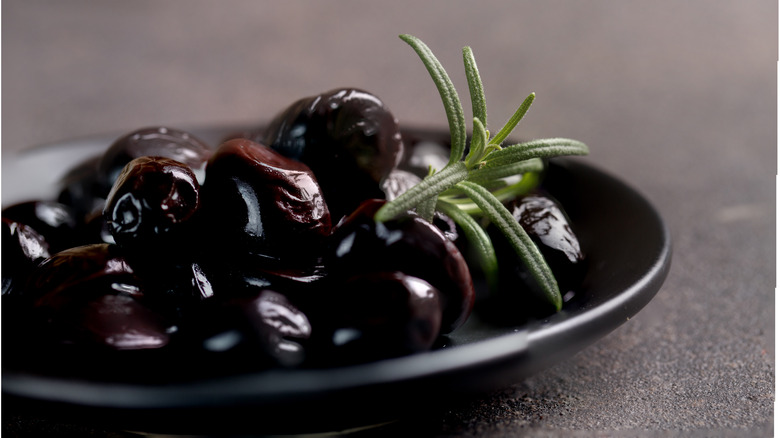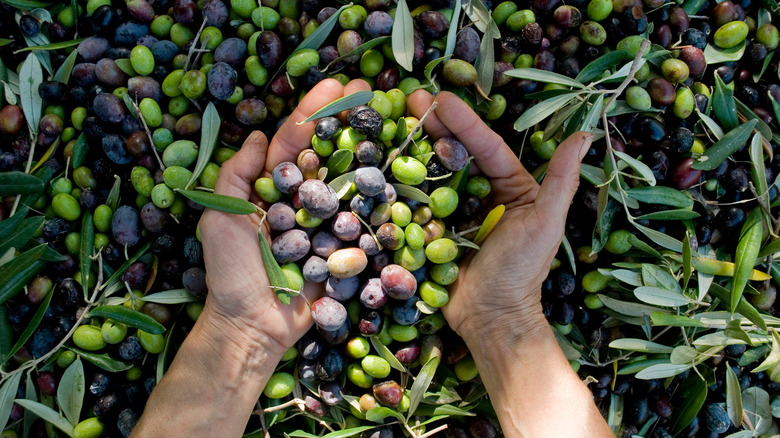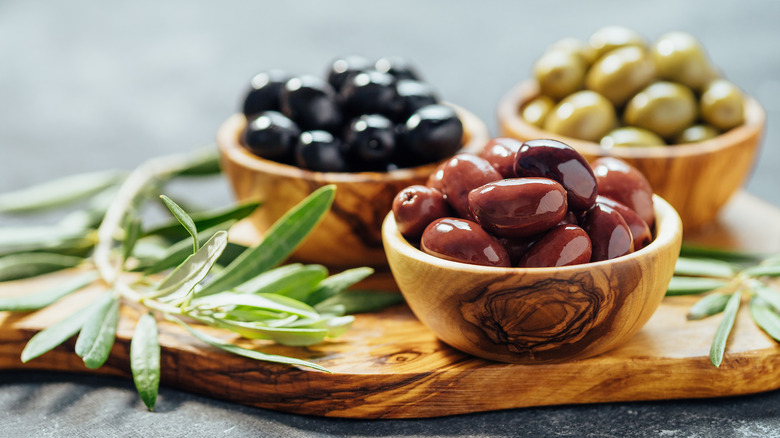The Real Reason Black Olives Are Always Canned
If you're a regular at the olive bar of your local grocery store, you may not have noticed the packaging for olives on the shelves. But when taking a stroll down the aisles, you'll find that green olives are packaged in a clear glass jar, while black olives come in a can.
Although canned black olives are always pitted, you might miss the label on a glass jar of green olives and munch down on a rock-hard seed by mistake. However, the pits are not the reason that black olives are canned — and neither is the fact that black olives are simply not as pretty as green olives. It actually has to do with health concerns.
The story behind the conversion from a jar to a can is a not-so-happy one. But, according to the Oroville Mercury-Register, the brains behind briny black olives themselves is Freda Ehmann, a German widow and farmer who helped launch California's olive industry.
The beginning of black olives
According to Marketplace, Freda Ehmann invented the black olive, also known as the California ripe olive. (What you may not know about olives is that the green ones are actually picked before they're ripe and later pickled green, which is why they're much firmer than black olives. And the darker the color, the more ripe they are).
In the 1890's, Ehmann's olive ranch in Oakland didn't spark much attention by the community, but after she approached the University of California for tips on speeding up the ripening process of the fruit, her business officially started. It took her months of hard work, but once she perfected her recipe, she sold locally until her olive business started booming, leading her to expand orchards nationally with factories. She was originally packaging the olives in barrels with a loose seal. Then, in glass jars to prevent any liquid from spilling. While this made for prettier packaging, the innovative technique to properly seal the jars spelled disaster.
The tragedy of olives
According to Food Safety News, a deadly outbreak of botulism in canned ripe olives spread across three states in 1919, killing 19 people. This occurrence still remains in the top 10 deadliest food outbreaks in American history. But how did they trace it back to olives?
In August of that year, a dinner party took place at a country club in Ohio where 14 people got severely sick and seven died. Epidemiologists did some digging and retraced the guests steps from that night, marking who sat where and what that person ate. A food the ill all had in common were in fact, olives. After the dinner ceased, a few waitstaff were cleaning the tables and snacking on the leftover olives when they noticed a funky flavor. They brought a few to the chef to try, claiming they didn't taste right. The chef tasted two for quality control and later died.
Following the deaths, the olives were traced back to the Ehmann Olive Company.
The canning process
The olive industry took a halt for about a decade, before canning became well-known and processed properly. According to Smithsonian Magazine, The National Canners Association and California Canners League took action to save the canning and food preservation industry. By 1925, procedures were put in place and other items such as sardines, tuna, and other vegetable products were also sold in cans. The kicker is that the cans need to be heated to 240 degrees Fahrenheit for a minimum of 40 minutes. A can would tolerate that, but a glass jar would bust. This would not only seal the food, but the heat would prevent spoilage, allowing canned goods to last longer.
Before this discovery, it seemed that heat was never in the equation. But as science progressed, microscopic equipment was created and microorganisms could then be seen, creating a better understanding of bacteria, how it grows, where it thrives, and how threatening it can be upon consumption.
The run-down on botulism
Lastly, what is botulism? It's a very deadly illness. According to the CDC, botulism is a collection of bacteria that creates spores that thrive in environments similar to conditions inside improperly canned goods. The conditions include places that are low-oxygen, low-acid, low-sugar, and low-salt. Once you consume food from a can that contains botulism, these toxins attack the body's nerves, causing trouble with muscle movement, breathing, and can lead to death. One way to prevent such a scary sickness is to do your research before canning goods at home and buy from the store if you can. Also, avoid buying dented cans as that can be a big risk factor (via Reader's Digest).
The riper the fruit is, the more gas it releases, allowing it to deteriorate and create an ideal environment for bacteria to grow. So, with green olives being unripe, a jar is a safe space for it to be stored, while black olives are fully ripe (hence their color) and need proper storage to be preserved for the shelves.
As of 2022, there are only two canned olive companies in California, Bell Carter Foods, Inc. and Musco Family Olive Co. And as for Ehmann, she eventually retired, distraught at how the canning industry had harmed the health of so many (via Marketplace).




